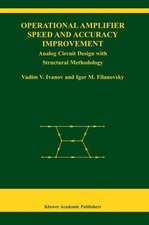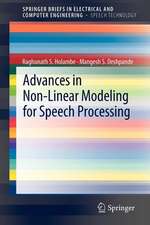Antenna Handbook: Theory, Applications, and Design
Autor Y.T. Lo, S. W. Leeen Limba Engleză Paperback – 12 mar 2013
| Toate formatele și edițiile | Preț | Express |
|---|---|---|
| Paperback (1) | 1001.82 lei 38-44 zile | |
| Springer Us – 12 mar 2013 | 1001.82 lei 38-44 zile | |
| Hardback (3) | 956.99 lei 43-57 zile | |
| Springer Us – 30 oct 1993 | 956.99 lei 43-57 zile | |
| Springer Us – 30 oct 1993 | 983.34 lei 43-57 zile | |
| Springer Us – 30 oct 1993 | 1257.66 lei 43-57 zile |
Preț: 1001.82 lei
Preț vechi: 1318.18 lei
-24% Nou
Puncte Express: 1503
Preț estimativ în valută:
191.76€ • 208.36$ • 161.18£
191.76€ • 208.36$ • 161.18£
Carte tipărită la comandă
Livrare economică 16-22 aprilie
Preluare comenzi: 021 569.72.76
Specificații
ISBN-13: 9781461564614
ISBN-10: 1461564611
Pagini: 2332
Ilustrații: XXI, 2305 p. In 3 volumes, not available separately.
Dimensiuni: 191 x 235 x 129 mm
Greutate: 4.11 kg
Ediția:Softcover reprint of the original 1st ed. 1988
Editura: Springer Us
Colecția Springer
Locul publicării:New York, NY, United States
ISBN-10: 1461564611
Pagini: 2332
Ilustrații: XXI, 2305 p. In 3 volumes, not available separately.
Dimensiuni: 191 x 235 x 129 mm
Greutate: 4.11 kg
Ediția:Softcover reprint of the original 1st ed. 1988
Editura: Springer Us
Colecția Springer
Locul publicării:New York, NY, United States
Public țintă
ResearchDescriere
Techniques based on the method of modal expansions, the Rayleigh-Stevenson expansion in inverse powers of the wavelength, and also the method of moments solution of integral equations are essentially restricted to the analysis of electromagnetic radiating structures which are small in terms of the wavelength. It therefore becomes necessary to employ approximations based on "high-frequency techniques" for performing an efficient analysis of electromagnetic radiating systems that are large in terms of the wavelength. One of the most versatile and useful high-frequency techniques is the geometrical theory of diffraction (GTD), which was developed around 1951 by J. B. Keller [1,2,3]. A class of diffracted rays are introduced systematically in the GTD via a generalization of the concepts of classical geometrical optics (GO). According to the GTD these diffracted rays exist in addition to the usual incident, reflected, and transmitted rays of GO. The diffracted rays in the GTD originate from certain "localized" regions on the surface of a radiating structure, such as at discontinuities in the geometrical and electrical properties of a surface, and at points of grazing incidence on a smooth convex surface as illustrated in Fig. 1. In particular, the diffracted rays can enter into the GO shadow as well as the lit regions. Consequently, the diffracted rays entirely account for the fields in the shadow region where the GO rays cannot exist.
Cuprins
A. Fundamentals and Mathematical Techniques.- 1. Basics.- 2. Theorems and Formulas.- 3. Techniques for Low-Frequency Problems.- 4. Techniques for High-Frequency Problems.- B. Antenna Theory.- 5. Radiation From Apertures.- 6. Receiving Antennas.- 7. Wire and Loop Antennas.- 8. Horn Antennas.- 9. Frequency-Independent Antennas.- 10. Microstrip Antennas.- 11. Array Theory.- 12. The Design of Waveguide-Fed Slot Arrays.- 13. Periodic Arrays.- 14. Aperiodic Arrays.- 15. Reflector Antennas.- 16. Lens Antennas.- C. Applications.- 17. Millimeter-Wave Antennas.- 18. Practical Aspects of Phased Array Design.- 19. Beam-Forming Feeds.- 20. Antennas on Aircraft, Ships, or Any Large, Complex Environment.- 21. Satellite Antennas.- 22. Remote Sensing and Microwave Radiometry.- 23. Antennas for Geophysical Applications.- 24. Antennas for Medical Applications.- 25. Direction-Finding Antennas.- 26. Standard AM Antennas.- 27. TV and FM Broadcast Antennas.- D. Related Topics.- 28. Transmission Lines and Waveguides.- 29. Propagation.- 30. Antenna Response to Electromagnetic Pulses.- 31. Radome Electromagnetic Design.- 32. Measurement of Antenna Radiation Characteristics on Far-Field Ranges.- 33. Near-Field Far-Field Antenna Measurements.- Appendixes.- A. Physical Constants, International Units, Conversion of Units, and Metric Prefixes.- B. The Frequency Spectrum.- C. Electromagnetic Properties of Materials.- D. Vector Analysis.- E. VSWR Versus Reflection Coefficient and Mismatch Loss.- F. Decibels Versus Voltage and Power Ratios.

























